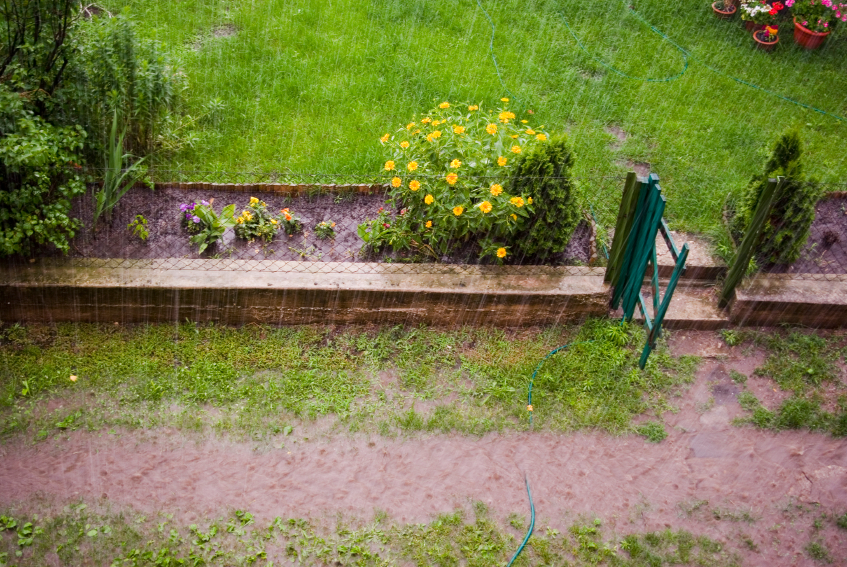 |
The development and implementation of the BMP is what ultimately decides the effectiveness of an SWPPP. In managing stormwater, BMPs can be broken down into two types: structural BMPs and nonstructural BMPs. Today, we will focus on structural BMPs (which as you can imagine are physical structures) in the form of rain gardens.
EcoGro, based in Lexington, Kentucky, was created in 2006 as a new division of Advanced Mulching Technologies, Inc. EcoGro is a contracting and consulting group that uses ecological solutions to resolve degradation of local natural areas.
The Advisor spoke to Russ Turpin, the senior environmental specialist with EcoGro, about rain gardens as effective BMPs for industrial facilities.
Advisor: Tell us a little bit about how you came to EcoGro.
RT: I’ve been with EcoGro since its inception as a branch of the parent company Advanced Mulching Technologies. Back then we were doing basically compliance work for homebuilding contractors and helping in the development of SWPPPs. EcoGro is meant to fill a niche as a full-service company, i.e., we design, develop, install, and maintain BMP structures for controlling stormwater at your facility.
Advisor: As we pointed out, SWPPPs have to include BMPs. How did the concept of a rain garden as a BMP evolve?
RT: I’m not sure where the idea for a rain garden originally came from, but the environmental processes they employ are ancient. My awareness of rain gardens came around 2001 through my interest in using natural processes to address stormwater. Overall interest in industry for infiltrating stormwater came as a response to regulations about water quality—permittees now had to address stormwater runoff quality.
Advisor: On your website, you highlight some projects that involved rain gardens. The Coke Bottle Rain Garden was particularly fun. How did that project come to be?

Photograph taken from Google Earth.
Join us for the Rain Gardens webinar on April 21 to get insight you can use to design your rain garden or other mitigation plans. Learn more.
RT: Back in 2008 I had been meeting with a group of folks in Lexington concerned with water quality. We saw what other cities were doing to promote rain gardens and formed a nonprofit group called the Bluegrass Rain Garden Alliance to advocate for these practices in Central Kentucky. As part of the education and outreach efforts, we looked for a local champion to set the stage for rain gardens. Stormwater engineers with the city of Lexington connected us with the local Coca-Cola affiliate based on a previous partnership. Our partners had acquired partial grant funding to contribute towards the Coca-Cola bottle project. Now, there is a more formal initiative in the city of Lexington to develop rain gardens. Lexington runs a Stormwater Quality Projects Incentive Grant Program and provides financial assistance for projects in the community that improve water quality, address stormwater runoff, and educate the public about these issues [Advisor Note: more about that later]. Funding for a second Coca-Cola rain garden came from this city stormwater grant.
Advisor: Do the rain gardens you build necessarily use native flora and fauna?
RT: Yes. It is not a requirement, but native plants typically do much better. They have more extensive root systems and are more tolerant of the amount of water that comes in. For instance, in Fayette County [the county Lexington is in], we get periods of lots of rain and then long stretches without water. Native plants are more tolerant of the local natural processes. The bugs and other small animals that help support the rain garden come on their own—they gravitate toward the native plants. Because we use native plants there is an ecological history with the two—a long-term natural relationship.

Photograph copyright Russ Turpin. Used with permission.
Rain Gardens: Evaluating the Use of Stormwater Best Management Practices (BMPs) to Meet Permit Requirements and Water Quality Standards
Register now to learn which mitigation strategies, including implementing a rain garden program, are best for your organization. Register today!
Advisor: In terms of life-span costs, I can see how you can predict the design and construction costs, but there have to be significant maintenance costs for such a project as the Coke Bottle Rain Garden. How did you build maintenance costs in the ROI calculations?

Photograph copyright Russ Turpin. Used with permission.
RT: Because we are an “all-in-one” service company [Advisor Note: EcoGro designs, develops, builds, and maintains their projects] we have a lot of experience with maintenance. When we are working in the design, we already have some projection for the maintenance that will be involved. I track the maintenance at every site we work on. So, our experience and tracking information help us determine the maintenance costs. To tell you the truth, maintenance is not a significant cost for rain gardens. Part of the attraction of rain gardens is the much lower maintenance cost, for example, versus turf grass. Once a rain garden is established—which takes about 3 years—there is very little maintenance because the native plants and animals recreate the natural environment. So you have a 3 to 5-year maintenance program to get the system established and then a declining amount of maintenance with a self-supporting system. My goal is to turn the clock back to the environment before development and recreate a natural ecosystem.

Photograph copyright Russ Turpin. Used with permission.

Although it’s nice to see companies that specialize in “ecological solutions” in response to stormwater runoff pollution, the fact is that more government buildings aren’t incorporating similar practices when designing (or redesigning) their landscaping schemes. This is all the more puzzling since the EPA has stated publicly that stormwater runoff pollution is the most serious threat to our nation’s waterways.